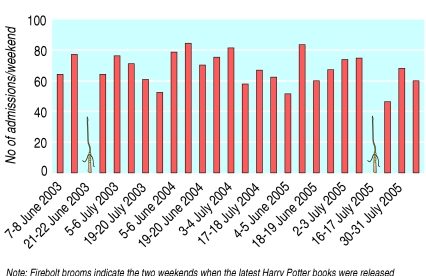Harry Potter and the Need for Fewer Casts

In June of 1997, the world changed for the better — “Harry Potter and the Philosopher’s Stone” debuted on bookshelves in the UK. In September 1998, it would appear in the United States under the title “Harry Potter and the Sorcerer’s Stone.” In total, readers have purchased more than 100 million copies of the book, making it one of the best selling books of all time. And if you include the other six books in the series, the grand total of Harry Potter books sold comes in at half a billion copies.
As those who lived through that era of Pottermania will attest, the last few books were some of the most highly anticipated novels that one can remember. Children and adults alike waited with bated breath for the newest story to arrive at their local bookstores, libraries, or more often than not, in the mail.
And it turns out, these latter books probably had a little bit of real-life magic behind them: they kept kids out of the hospital.
In 2005, a group of researchers published a paper called “Harry Potter casts a spell on accident-prone children,” which is a missed opportunity — “Harry Potter and Spell of St. Mungo’s” would have been a better one. But that aside, the paper is pretty good. In a footnote, the authors explain that one of them, Keith Willet, “conjured up the original idea for the work having experienced a quiet on-call weekend, then witnessing three of his children ‘petrified’ on the sofa.” Specifically, Willet noted, his children were too busy reading to be doing things like rollerblading, scootering, or just generally roughhousing with one another. As the paper states, “given the lack of horizontal velocity, height, wheels, or sharp edges associated with this particular craze, [the authors] were interested to investigate the impact the Harry Potter books had on children’s traumatic injuries during the peak of their use.”
The researchers, who all worked at John Radcliffe Hospital in Oxford, England, decided to use the data from their own institution. Specifically, they did a weekend-by-weekend tally “of all children aged 7-15 who attended [their] emergency department with musculoskeletal injuries over the summer months of a three year period.” What they found is summarized in the chart below (via the paper).

The fifth book, “Harry Potter and the Order of the Phoenix,” came out on June 21, 2003. That weekend, their ER saw only 36 qualifying visits, down from 77 the week prior and 63 the week after. Book six, “Harry Potter and the Half-Blood Prince,” came out on July 16, 2005, with similar results — 37 qualifying ER visits that weekend, compared to 75 the week before and 46 the week after. (Book six is really long, too, so it shouldn’t be all that surprising that the hospital visit rate climbed to 68 visits a week after that.)
So can Harry Potter keep children healthier? Maybe. The authors wondered, likely jokingly, if “there is a place for a committee of safety-conscious, talented writers who could produce high-quality books for the purpose of injury prevention.” But they quickly dismissed that, noting that “potential problems with this project would include an unpredictable increase in childhood obesity, rickets, and loss of cardiovascular fitness.”
Perhaps the best solution is to simply invent Skele-Gro.
Bonus fact: “Expecto patronum” is probably one of the most recognizable Harry Potter spells; if you don’t know what it is, you probably need to re-read the books and/or re-watch the movies. For those who know what it does, congrats! You also speak a little bit of Latin. “Expecto patronum” is Latin for “I await a guardian.”
From the Archives: The Harry Potter Fan Who Was Worthy of Gryffindor: A bittersweet but touching story.
